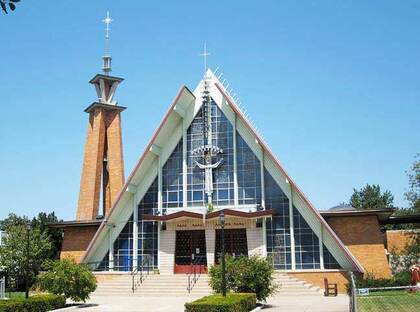Maspeth, in a western corner of Queens east of Greenpoint and Williamsburg and west of Middle Village, is stuck between the grit of Brooklyn and the airy, almost suburban atmosphere enveloping its eastern and southern neighbors. Maspeth was first settled by Native-Americans centuries before Dutch and English colonists arrived in the mid-1600s. It became a part of the borough of Queens, and then New York City in 1898. “Maspeth” is derived from Delaware Indian terms that have, by different accounts, meant “great brook” or “place of rising tides” due to its western end being situated next to Newtown Creek.
There are a couple of artifacts in Maspeth that are head-scratchers, as there are a couple of pieces of infrastructure that reference a neighborhood a couple of miles away, Ridgewood. There are a pair of brick posts on 53rd Ave. east of 65th Pl., and a pair of more elaborate archways on 65th Pl. at Jay Ave. What are these Ridgewood items doing here? Have they been transplanted?
In 1928, much of Queens was largely unpopulated and unbuilt-upon. Ridgewood, however, was an, due to its proximity to Brooklyn, and real estate developers hoped to capitalize on the cachet of the neighborhood. By then, Ridgewood was dominated by attached brick and brownstone houses, as well as blocks of handsome, yellow-bricked apartments constructed by developer Gustave X. Mathews. He built from materials created in the Staten Island kilns of Balthazar Kreischer.

In that year, the developers Realty Associates purchased 70 acres in a neighborhood then labeled as “North Ridgewood” but now a part of northern Maspeth roughly defined by Maurice Ave., 64th St., Grand Ave. and 74th St. Builder John Aylmer constructed two and six-family homes in the newly-named Ridgewood Plateau, so named for its location atop one of Queens’ higher hills.

A pair of stone markers on either side of 53rd Ave. east of 65th Pl. helps identify the development, though why this location was selected for them remains a mystery. A quartet of iron arches at 65th Pl., Maurice Ave. and Jay Ave., marks the northern and southern ends of the development. The words “Ridgewood Plateau” were painted in gold leaf on a plaque attached to the iron arches’ apices.
Over time, the iron arches became rusted and the gold leaf was worn off. Occasionally, an iron arch would be painted, but no real ongoing maintenance would be performed until 2014 when the Juniper Park Civic Association, the Newtown Historical Society, Maspeth Federal Savings, the Communities of Maspeth and Elmhurst Together and Maspeth’s O’Neill’s Restaurant arranged for the restoration of the arches by Woodside artisan Larry Madine.

As part of the 1928 development, 65th Pl. was paved and graded from Roosevelt to Grand Aves. Along with 69th St., once called Fisk Ave., 65th Pl. provides a direct vehicular route from Woodside to what was once Ridgewood Plateau. The brickwork on the arches at Jay Ave. preserve 65th Pl.’s former name, Hyatt Ave. In the 1920s, most of Queens streets were given numbers to eliminate duplicate names.

At 65th Pl. and Jay Ave., Federalist Triangle, seen here on a tour of the area I gave with Newtown historical a few years ago, owns a name inspired by the adjacent Hamilton Pl., named for Alexander Hamilton (1755-1804), and the Federalist movement of which he was a participant. In 1787, Hamilton attended the Constitutional Convention in Philadelphia. An ardent believer in Federalism, Hamilton argued vigorously for the Constitution’s ratification in a series of articles co-authored with James Madison (1751-1836) and John Jay (1745-1829), known today as the Federalist Papers.
The corner is also known as Cowbird Triangle. Playfully named by the late Parks Commissioner Henry Stern in 1997 after Borden Ave.’s eastern end at 69th Str. (the Borden Milk Company’s mascot was Elsie the Cow) and the jaybird, for Jay Ave. This park was once named Alexander Triangle, after nearby Hamilton Pl. In recent years it was also renamed the Technical Sergeant Thomas J. Davey Triangle after a local resident who died in battle during the Vietnam War.

One of the most gorgeous buildings in Queens is the Church of the Transfiguration, on Perry Ave. east of 64th St. The first Transfiguration was built in 1909 to serve the swelling population of Lithuanian immigrants. The present structure dates from 1962. Lithuanian folk art elements adorn the inside of the church. The Lithuanian phrase above the doors, Mano Namai Maldos Namai means “My house is a house of prayer.” Multiple Masses are still celebrated in the Lithuanian language each weekend. A replica of a Lithuanian roadside shrine sits in the churchyard of Transfiguration R.C. Church.
The church was forced to close by declining patronage, and developers are hungrily eyeing the property for redevelopment, as the church has never been landmarked.
—Kevin Walsh is the webmaster of the award-winning website Forgotten NY, and the author of the books Forgotten New York (HarperCollins, 2006) and also, with the Greater Astoria Historical Society, Forgotten Queens (Arcadia, 2013)

